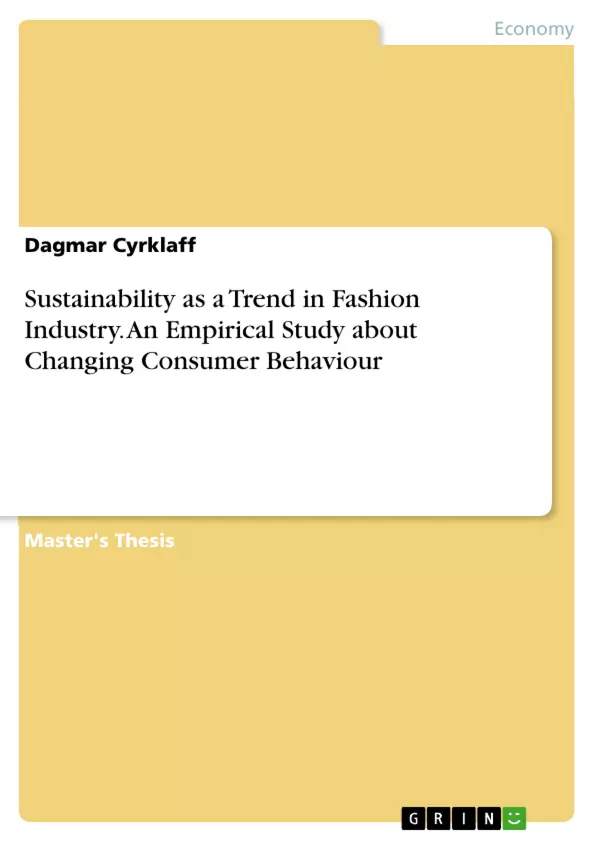A trend in society to take care of environmental issues is observed and the generation born around the millennium shift between 1980 and 2000, so called generation Y, became a growing consumer market in Germany. Fashion is one of the most consumed segments by the Millennials, who value transparent production and are sensitive to environmental issues at the same time. This study seeks to provide a current status of the generation Y’s knowledge, attitude and behaviour in regards to fashion consumption with the impact of sustainability.
A literature review and an online survey have been conducted to analyse the consumer behaviour of 84 Generation Y consumers, aged 17 to 37 in 2017.
The major result shows that there is no significant difference in attitude and behaviour towards a sustainable development between consumers that live a conscious life and conventional consumers. Sustainability as a topic has reached Millennials, who should further deepen their knowledge in order to foster a sustainable development in fashion.
Inhaltsverzeichnis (Table of Contents)
- Theoretical Part
- Introduction to the Topic of Sustainability as a Trend in Fashion Industry
- Objective of the Present Study
- Structure of the Present Study
- Fundamentals of Sustainable Fashion
- Concept of Sustainability
- Concept of Fashion
- Fast Fashion versus Slow Fashion
- Sustainability as a Trend in Fashion Industry
- Corporate Social Responsibility in Fashion Industry
- Life Cycle Assessment of Fashion Products
- Supply Chain in Fashion Industry
- Consumer Behaviour in Fashion
- Buying Behaviour Process
- Activating Sub-Process
- Cognitive Sub-Process
- Predisposing Sub-Process
- Involvement
- Social Determinants
- Cultural Determinants
- Development of Sustainable Consumer Behaviour
- Lifestyle of Health and Sustainability
- Conscious Consumer Behaviour
- Drivers of Buying Decision in Sustainable Fashion
- Barriers of Buying Decision in Sustainable Fashion
- After-Purchase Behaviour in Fashion
- Sustainable Fashion Knowledge
- Attitude-Behaviour Gap in Sustainable Fashion
- Forecast of Future Development regarding Sustainability in Fashion
- Empirical Part
- Hypothesis Formation on Consumer Behaviour in Fashion Industry
- Buying Attributes of Conscious Consumers
- Consumer's Sustainable Knowledge on Fashion Brands
- Willingness to Pay for Sustainable Fashion
- After-Purchase Behaviour by Gender
- Impulsiveness of Buying Decisions in Fashion
- Study Design of Survey on Consumer Behaviour in Fashion
- Questionnaire on Consumer Behaviour in Fashion
- Implementation of Survey on Consumer Behaviour in Fashion
- Study Results of Survey on Consumer Behaviour in Fashion
- Group Formation for Survey on Consumer Behaviour in Fashion
- Hypotheses Results
- Buying Attributes of Conscious Consumers
- Consumer's Knowledge on Fashion Brands
- Willingness to Pay for Sustainable Fashion
- After-Purchase Behaviour by Gender
- Impulsiveness of Buying Decisions in Fashion
- Discussion of Survey Results on Consumer Behaviour in Fashion
- Hypotheses Examination of Consumer Behaviour in Fashion
- Buying Attributes of Conscious Consumers
- Consumer's Knowledge on Fashion Brands
- Willingness to Pay for Sustainable Fashion
- After-Purchase Behaviour by Gender
- Impulsiveness of Buying Decisions in Fashion
- Limitations of Study on Consumer Behaviour in Fashion
- Implementation for Fashion Industry based on Study on Consumer Behaviour
- Conclusion of Study on Consumer Behaviour in Fashion Industry
- The growing trend of sustainability in the fashion industry
- The role of consumer behavior in driving sustainable fashion practices
- The factors influencing consumer purchase decisions regarding sustainable fashion
- The relationship between consumer knowledge and their willingness to pay for sustainable fashion
- The impact of gender on consumer behavior and after-purchase behavior in relation to sustainable fashion
- The first chapter introduces the topic of sustainability as a trend in the fashion industry, outlining the objective and structure of the study.
- Chapter 2 delves into the fundamentals of sustainable fashion, defining the concepts of sustainability and fashion, and contrasting fast fashion with slow fashion.
- Chapter 3 explores the growing trend of sustainability in the fashion industry, examining corporate social responsibility, life cycle assessment of fashion products, and the role of the supply chain.
- Chapter 4 focuses on consumer behavior in fashion, examining the buying behavior process, including activating, cognitive, and predisposing sub-processes. It also explores the development of sustainable consumer behavior, drivers and barriers of buying decisions in sustainable fashion, and after-purchase behavior.
- Chapter 5 forecasts future developments regarding sustainability in the fashion industry.
- Chapter 6 outlines the hypothesis formation on consumer behavior in the fashion industry, focusing on buying attributes of conscious consumers, consumer's sustainable knowledge on fashion brands, willingness to pay for sustainable fashion, after-purchase behavior by gender, and impulsiveness of buying decisions in fashion.
- Chapter 7 describes the study design of the survey on consumer behavior in fashion, including the questionnaire and implementation of the survey.
- Chapter 8 presents the study results of the survey on consumer behavior in fashion, including group formation and hypotheses results.
- Chapter 9 discusses the survey results on consumer behavior in fashion, examining the hypotheses, limitations of the study, and potential implementations for the fashion industry based on the findings.
Zielsetzung und Themenschwerpunkte (Objectives and Key Themes)
This master's thesis aims to investigate the changing consumer behavior towards sustainable fashion. It explores the factors influencing consumers' decisions to purchase sustainable fashion products and analyzes the impact of sustainability on the fashion industry. The study utilizes empirical data collected through a survey to understand the buying attributes, knowledge, willingness to pay, after-purchase behavior, and impulsiveness of consumers in relation to sustainable fashion. The key themes explored in this study include:Zusammenfassung der Kapitel (Chapter Summaries)
Schlüsselwörter (Keywords)
This study focuses on the intersection of sustainability and consumer behavior in the fashion industry. Key terms include: sustainable fashion, consumer behavior, buying attributes, knowledge, willingness to pay, after-purchase behavior, impulsiveness, fast fashion, slow fashion, corporate social responsibility, life cycle assessment, supply chain, and attitude-behavior gap.- Quote paper
- Dagmar Cyrklaff (Author), 2017, Sustainability as a Trend in Fashion Industry. An Empirical Study about Changing Consumer Behaviour, Munich, GRIN Verlag, https://www.grin.com/document/367167



